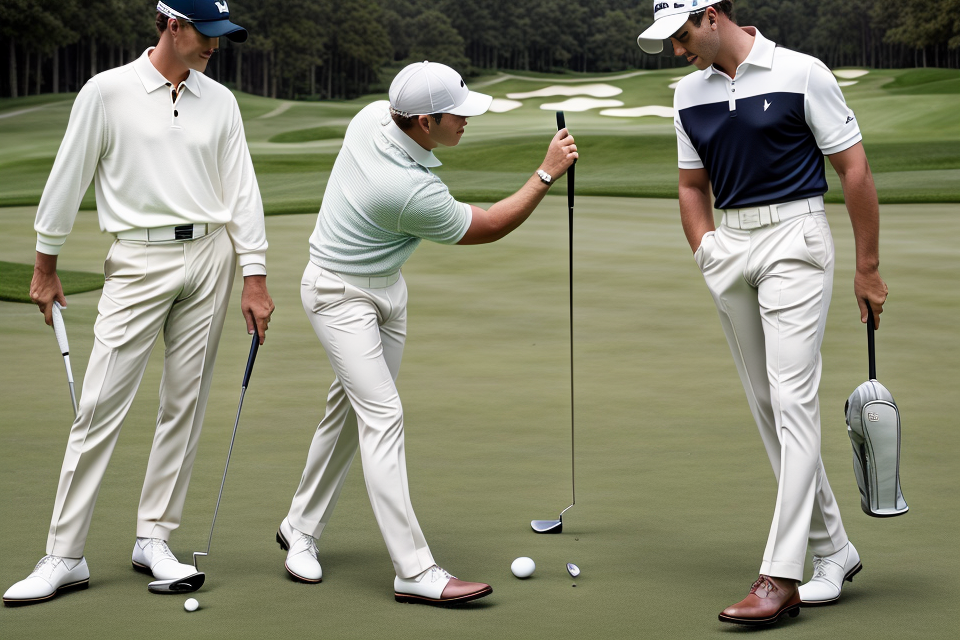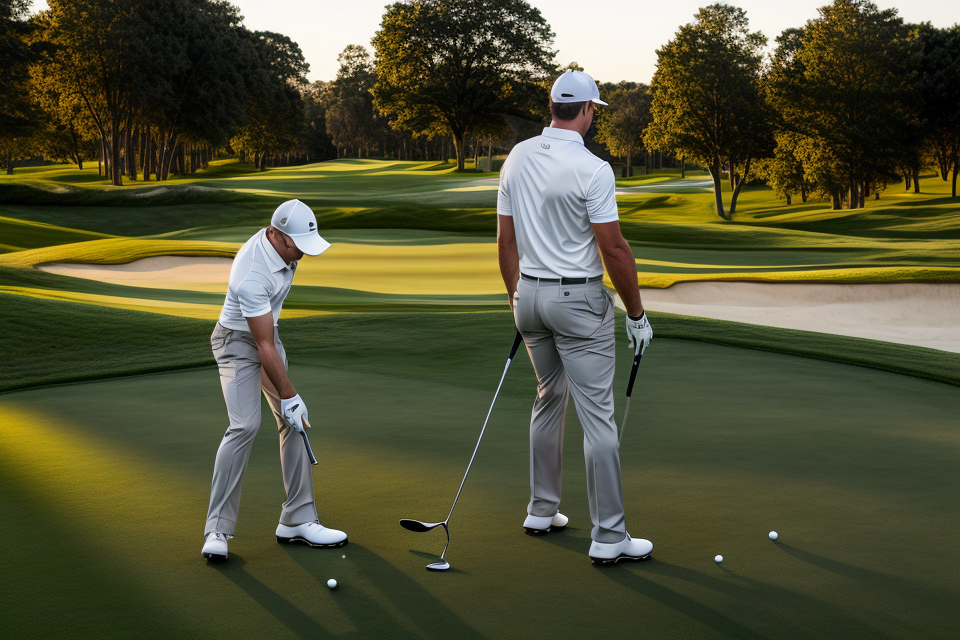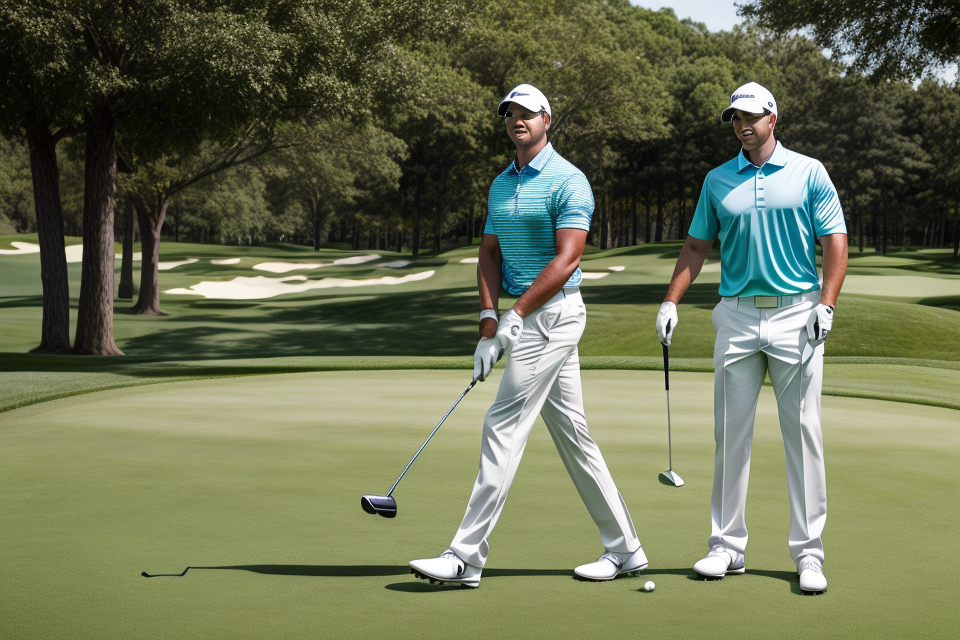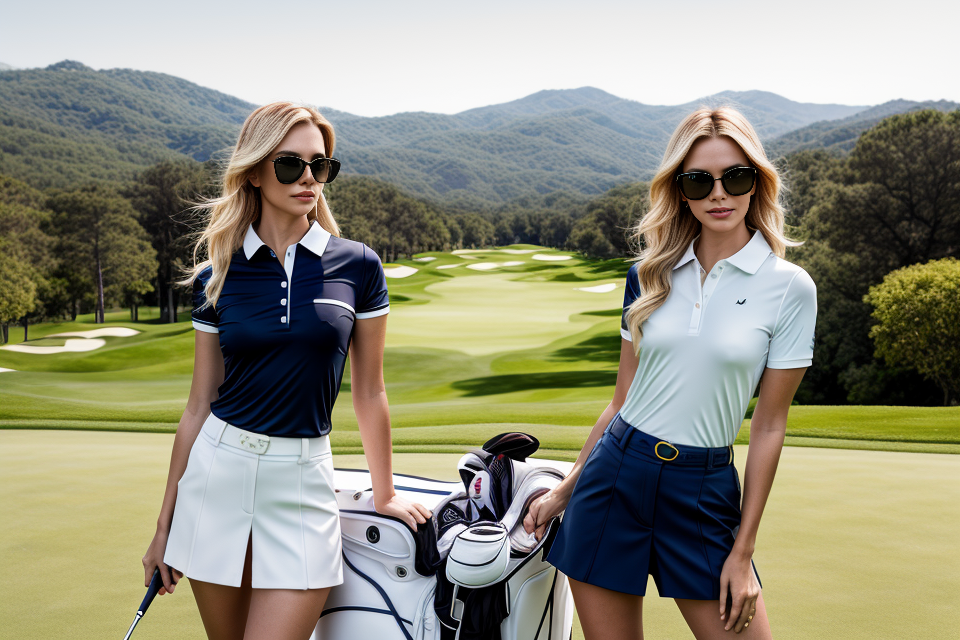
Golf fashion has undergone a remarkable transformation over the years. From its humble beginnings as a sport for the elite, golf fashion has evolved into a billion-dollar industry that caters to the sartorial needs of golfers worldwide. In this article, we will take a look at the evolution of golf fashion, exploring how the sport has influenced fashion trends and how fashion has, in turn, shaped the sport. From the classic polo shirts and knickers of the 1920s to the modern, technical apparel of today, we will examine the historical milestones that have defined the sport’s style. Whether you’re a die-hard golfer or simply a fashion enthusiast, this article promises to provide an interesting and insightful perspective on the fascinating world of golf fashion.
The Origins of Golf Fashion
The Influence of Traditional Scottish Attire
Golf originated in Scotland, and its fashion evolution is deeply rooted in the country’s traditional attire. Scotland’s weather, which is characterized by rain and wind, influenced the type of clothing worn by golfers. As a result, early golfers adapted their traditional clothing to suit the demands of the sport.
Traditional Scottish attire played a significant role in shaping golf fashion. Men and women in Scotland traditionally wore kilts, plaids, and woolen garments, which were made from the country’s abundant wool. These garments were functional and provided protection against the elements. The clothing was also a reflection of Scottish heritage and culture.
In golf, the influence of traditional Scottish attire can be seen in the development of the iconic golf knickers, also known as “plus fours.” These knickers, which extend four inches above the knee, were initially worn as a practical alternative to the traditional knee-length kilts. The longer length provided additional protection against the elements, while still allowing for a full range of motion during golf swings.
Another aspect of traditional Scottish attire that influenced golf fashion was the use of plaids. Plaids were initially worn as a means of identifying clan affiliation. In golf, plaids were incorporated into the sport’s fashion as a way to showcase Scottish heritage and culture. Golfers began wearing plaid golf shirts, which eventually became a staple of golf fashion.
The influence of traditional Scottish attire on golf fashion cannot be overstated. The sport’s origins in Scotland and the need to adapt to the country’s weather led to the development of distinctive golf attire. The use of kilts, plaids, and woolen garments inspired the design of golf clothing, including the iconic golf knickers and plaid golf shirts. As golf spread to other parts of the world, the influence of traditional Scottish attire continued to shape the sport’s fashion.
The Evolution of Golfing Apparel for Women
Golf fashion has evolved significantly over the years, particularly when it comes to the apparel designed for women golfers. From the early days of women’s golf, when women were expected to wear practical and modest clothing, to the modern era of golf fashion, where women can choose from a wide range of stylish and functional golf apparel, the evolution of women’s golfing attire has been marked by a number of key developments.
One of the earliest innovations in women’s golf apparel was the development of the “golfing costume,” which was first introduced in the late 19th century. These costumes were typically made of heavy woolen fabrics and were designed to be both practical and modest. They typically featured long sleeves, high necklines, and were often paired with a hat or veil to protect the golfer from the sun.
In the early 20th century, as golf became more popular among women, the golfing costume began to evolve. Manufacturers began to experiment with lighter fabrics, such as silk and linen, and designs became more form-fitting and fashionable. By the 1920s, women’s golf apparel had become much more stylish, with hemlines rising and sleeves becoming shorter.
During the 1930s and 1940s, women’s golf apparel continued to evolve, with designers experimenting with new fabrics and cuts. The classic polo shirt, for example, was first introduced in the 1930s as a more comfortable and practical alternative to traditional dresses and blouses.
In the post-World War II era, women’s golf apparel underwent a significant transformation. With the rise of sportswear in the 1950s and 1960s, golf apparel became more casual and comfortable, with shorter skirts and more form-fitting pants and shirts. This trend continued into the 1970s and 1980s, with the rise of the women’s liberation movement leading to even more comfortable and practical golf apparel for women.
In recent years, golf fashion has continued to evolve, with designers pushing the boundaries of what is considered “appropriate” golf attire for women. Today, women golfers can choose from a wide range of stylish and functional golf apparel, including skirts, shorts, pants, and polo shirts, all designed to help them perform at their best on the golf course.
The Transformation of Golf Fashion in the 20th Century
The Impact of Technology on Golf Apparel
The advancements in technology have played a significant role in the evolution of golf fashion in the 20th century. These technological advancements have led to the development of new materials, designs, and fabrics that have revolutionized the way golfers dress on the course.
Polyester and Spandex
One of the most significant advancements in golf apparel has been the introduction of synthetic fabrics such as polyester and spandex. These materials are lightweight, durable, and moisture-wicking, making them ideal for golfers who need to stay cool and comfortable during their game. Polyester and spandex are also resistant to wrinkles, making them easy to maintain and wash.
Waterproof and Breathable Fabrics
Another technological innovation in golf apparel has been the development of waterproof and breathable fabrics. These fabrics are designed to keep golfers dry and comfortable in wet conditions, while also allowing them to release moisture vapor to prevent overheating. This technology has been particularly useful for golfers who play in rainy or humid climates.
Moisture-Wicking Technology
Moisture-wicking technology is another innovation that has transformed golf apparel. This technology is designed to draw sweat away from the body and evaporate it quickly, keeping golfers cool and dry during their game. Moisture-wicking fabrics are also breathable, allowing air to circulate around the body and keep it cool.
Stretch Technology
Stretch technology has also played a significant role in the evolution of golf apparel. This technology allows for greater mobility and flexibility, enabling golfers to move freely and comfortably during their swing. Stretch fabrics are also designed to be lightweight and breathable, making them ideal for golfers who need to stay cool and comfortable during their game.
3D Design and Customization
In recent years, technology has also enabled golf apparel to be designed using 3D printing and customization. This technology allows for a more personalized fit and greater comfort, as well as the ability to create unique designs and patterns. Customized golf apparel has become increasingly popular among golfers who want to stand out on the course and express their individuality.
In conclusion, the impact of technology on golf apparel has been significant and far-reaching. From synthetic fabrics to moisture-wicking technology, stretch fabrics, and customization, golfers now have access to a wide range of high-performance materials and designs that can help them play their best and look great on the course.
The Emergence of Golf as a Fashion Statement
The sport of golf has been transformed significantly over the years, and so has the fashion associated with it. Golf apparel has evolved from traditional and functional clothing to a fashion statement that reflects the latest trends in the fashion industry. This transformation began in the 20th century, with golfers seeking to express their personal style and individuality on the golf course.
One of the key factors that contributed to the emergence of golf as a fashion statement was the growth of professional golf. The rise of professional golf tournaments, such as the U.S. Open and the Masters, brought increased attention to the sport and the players who competed in them. As golfers became more visible, they began to pay more attention to their appearance, and the golf apparel industry began to take notice.
In the early 20th century, golfers typically wore formal attire on the golf course, including dress pants, a dress shirt, a tie, and a jacket. However, as the sport became more popular, golfers began to experiment with different styles and fabrics, and the traditional golf attire slowly began to evolve.
Golfers such as Arnold Palmer and Gary Player were among the first to bring a more casual style to the golf course. They were known for wearing polo shirts and golf slacks, which was a departure from the traditional formal attire of the time. This new look was not only more comfortable, but it also allowed golfers to express their personal style and individuality.
The emergence of golf as a fashion statement was also influenced by the wider cultural changes of the 20th century. As society became more casual, people began to adopt a more relaxed style of dress, and this trend was reflected in the golf apparel industry. Golfers started to choose clothing that was more comfortable and functional, such as golf shorts and polo shirts, which allowed them to move freely and play their best.
Today, golf fashion has become an integral part of the sport, with golfers and spectators alike paying close attention to the latest trends in golf apparel. Golfers can choose from a wide range of clothing options, including performance-enhancing fabrics, stylish designs, and bold colors. Golf fashion has become a reflection of personal style and individuality, and it continues to evolve as the sport and the fashion industry change.
Golf Fashion in the 21st Century
The Rise of Golf Streetwear
Golf fashion has come a long way since the early 20th century. Today, golfers are not only focused on their performance on the course, but also on their style. Golf streetwear has become increasingly popular in recent years, and many golfers are now choosing to wear golf-inspired streetwear rather than traditional golf attire.
The Emergence of Golf Streetwear
The rise of golf streetwear can be attributed to several factors. Firstly, the increasing popularity of streetwear fashion in general has led to a greater demand for golf-inspired streetwear. Secondly, the growing trend of athleisure wear has made golf streetwear more appealing to a wider audience.
The Popularity of Golf Streetwear Brands
There are now a number of brands that specialize in golf streetwear, such as Footjoy, Nike, and Under Armour. These brands offer a range of golf-inspired clothing and accessories, including hats, t-shirts, sweatshirts, and golf bags. Many of these brands also collaborate with fashion designers and influencers to create unique and stylish golf streetwear.
The Impact of Social Media on Golf Streetwear
Social media has played a significant role in the rise of golf streetwear. Platforms such as Instagram and TikTok have allowed golfers to showcase their style and share their favorite golf streetwear brands and pieces. This has created a community of golfers who are passionate about golf fashion and has helped to fuel the growth of the golf streetwear industry.
The Future of Golf Streetwear
As golf streetwear continues to gain popularity, it is likely that we will see even more innovative and stylish golf-inspired clothing and accessories in the future. With the continued influence of social media and the growing trend of athleisure wear, golf streetwear is sure to remain a significant part of the golf fashion landscape for years to come.
The Influence of Celebrities and Professional Athletes on Golf Fashion
Celebrities and professional athletes have played a significant role in shaping the fashion trends in golf. These individuals are often seen as fashion icons and their choices and preferences influence the buying decisions of millions of people around the world. Golf fashion designers and brands often collaborate with celebrities and athletes to create exclusive lines of golf apparel that are stylish and functional.
One of the most notable collaborations in golf fashion was between the golf apparel brand, Puma Golf, and the professional golfer, Rickie Fowler. Fowler, who is known for his unique sense of style, has been a long-time collaborator with Puma Golf, and together they have created a range of stylish and colorful golf apparel that has become popular among young golfers.
Another example of the influence of celebrities on golf fashion is the partnership between the luxury fashion brand, Gucci, and the professional golfer, Rory McIlroy. Gucci has been a major sponsor of McIlroy for several years, and the two have worked together to create a line of golf apparel that combines the luxury and style of Gucci with the performance and functionality of golf apparel.
The influence of celebrities and professional athletes on golf fashion is not limited to the collaborations and partnerships. These individuals are also often seen wearing the latest golf fashion trends on the golf course and in their personal lives. This has helped to raise the profile of golf fashion and has made it more mainstream and accessible to a wider audience.
In conclusion, the influence of celebrities and professional athletes on golf fashion cannot be overstated. These individuals have played a significant role in shaping the fashion trends in golf and have helped to make it more mainstream and accessible to a wider audience. Through their collaborations, partnerships, and personal style choices, they have helped to raise the profile of golf fashion and have made it a more important aspect of the sport.
The Future of Golf Fashion
Sustainable and Eco-Friendly Golf Apparel
Embracing Sustainability in Golf Apparel
Golf apparel manufacturers have increasingly embraced sustainability and eco-friendliness in their designs. The move towards sustainable golf apparel is a response to the growing demand for environmentally responsible products and the need to reduce the fashion industry’s impact on the environment. Sustainable golf apparel encompasses clothing made from recycled materials, organic cotton, and innovative technologies that minimize environmental harm.
Recycled Materials in Golf Apparel
Recycled materials are becoming increasingly popular in golf apparel. Recycled polyester, for instance, is a commonly used fabric in golf apparel production. It is made from recycled plastic bottles, which would otherwise end up in landfills. The use of recycled materials in golf apparel reduces the demand for new raw materials, conserves energy, and minimizes the environmental impact of the manufacturing process.
Organic Cotton in Golf Apparel
Organic cotton is another sustainable material that is increasingly being used in golf apparel. Organic cotton is grown without the use of synthetic pesticides and fertilizers, making it a more environmentally friendly option compared to conventional cotton. Organic cotton is also softer and more durable than conventional cotton, making it a popular choice among golfers.
Innovative Technologies in Golf Apparel
Innovative technologies are also being used in the production of sustainable golf apparel. For example, some manufacturers are using bio-based materials, such as plant-based polyesters, to produce golf apparel. These materials are renewable and biodegradable, reducing the environmental impact of the manufacturing process. Additionally, some manufacturers are using innovative dyeing techniques that consume less water and energy compared to traditional methods.
The Benefits of Sustainable Golf Apparel
Sustainable golf apparel offers several benefits. Firstly, it reduces the environmental impact of the fashion industry, which is a significant contributor to pollution and climate change. Secondly, sustainable golf apparel is often made from high-quality materials that are durable and long-lasting, making them a more cost-effective option in the long run. Finally, sustainable golf apparel is often stylish and functional, making it an attractive option for golfers who want to look and feel their best on the course.
Conclusion
In conclusion, sustainable and eco-friendly golf apparel is the future of golf fashion. With growing concerns about the environment and the impact of the fashion industry on the planet, sustainable golf apparel offers a responsible and stylish alternative for golfers. As technology continues to advance, we can expect to see even more innovative and sustainable golf apparel options in the future.
The Influence of Social Media on Golf Fashion Trends
In recent years, social media has emerged as a significant force in shaping golf fashion trends. With the rise of platforms like Instagram, Facebook, and Twitter, golf enthusiasts have access to a wealth of information about the latest fashion trends and can easily share their opinions and recommendations with others.
One of the key ways in which social media has influenced golf fashion is by making it easier for designers and brands to connect with their target audience. By using social media to showcase their products and engage with customers, golf fashion brands can quickly gather feedback and make adjustments to their designs based on consumer preferences. This has led to a more democratic approach to fashion, with designers and brands taking into account the opinions of their customers when creating new products.
Another way in which social media has impacted golf fashion is by creating a platform for influencers and bloggers to share their thoughts and opinions on the latest trends. These influencers have amassed large followings by providing valuable insights and advice on everything from the best golf courses to play to the latest golf equipment and accessories. As a result, their opinions carry a lot of weight with their followers, and many golfers look to them for guidance when it comes to choosing what to wear on the course.
Social media has also had an impact on the way in which golfers themselves think about fashion. In the past, golf was often seen as a more conservative sport, with players tending to favor traditional clothing styles. However, with the rise of social media, golfers are now more willing to experiment with different styles and brands, and are more open to trying out new trends and looks. This has led to a greater diversity of fashion choices on the golf course, with players now opting for a wider range of clothing styles and colors.
Overall, the influence of social media on golf fashion trends cannot be overstated. By providing a platform for designers, brands, influencers, and golfers to connect and share their thoughts and opinions, social media has played a crucial role in shaping the future of golf fashion. As social media continues to grow and evolve, it is likely that its influence on golf fashion will only continue to increase.
FAQs
1. How has golf fashion changed over the years?
Golf fashion has come a long way since the sport’s inception in the 14th century. In the early days, golfers wore traditional Scottish attire such as kilts and plaids. However, as the sport gained popularity, the dress code became more formal, with players donning suits and ties on the course. Today, golf fashion has evolved to include a wide range of styles, from polo shirts and golf shorts to designer golf wear.
2. When did golfers start wearing golf clothing?
Golfers started wearing golf clothing in the late 19th century. Prior to this, players wore regular street clothes on the course. However, as the sport became more popular, golfers began to see the need for clothing specifically designed for golf. This led to the development of golf-specific clothing, such as knickers and plus-fours, which were popular in the early 20th century.
3. What influenced the change in golf fashion?
The change in golf fashion was influenced by a number of factors, including the rise of professional golf, the growth of the sport’s popularity, and advances in technology. As professional golfers began to dominate the sport, they set new standards for dress on the course. Additionally, the growth of the sport meant that more people were playing golf, and this led to an increased demand for golf-specific clothing. Finally, advances in materials and technology have made it possible to create high-performance golf clothing that is both comfortable and stylish.
4. What are some of the most iconic golf fashion trends?
Some of the most iconic golf fashion trends include the polo shirt, which was popularized by tennis player Fred Perry in the 1950s, and the argyle sweater, which became a staple of golf fashion in the 1960s. Other iconic golf fashion trends include the plus-four golf shorts, which were popular in the 1920s, and the golfer’s cap, which has been a staple of golf fashion for over a century.
5. How has technology impacted golf fashion?
Technology has had a significant impact on golf fashion. Advances in materials science have made it possible to create high-performance fabrics that are both comfortable and durable. Additionally, technologies such as moisture-wicking and breathable fabrics have made golf clothing more functional and practical. These innovations have led to the development of a wide range of golf-specific clothing, from moisture-wicking golf shirts to lightweight golf pants.


